Dog from the Mosaic
This article is a brief view of the history of the breeding of the Azawakh in the Czech Republic in the years when the breed was introduced in Europe. The beginning of the breeding of the Azawakh in Europe was not easy. The Azawakh as a breed was unknown and the first breed specimens were considered Sloughis and they were registered in studbooks as such. The then Czechoslovakia was no exception.
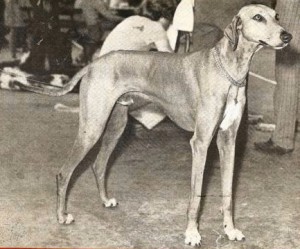
Gao
The tradition of the Azawakh breeding in this country dates back to the second half of the seventies of the twentieth century. At that time, the first specimens of the breed were imported to Czechoslovakia from the then Yugoslavia, from the Harris al Sahra kennel of Mrs. Vesna Sekalec. Mr. Pečar, a Yugoslavian diplomat, who had brought the first pair of Azawakhs from Africa, and later on also Mrs. Sekalec, participated repeatedly in the International Dog Shows in the city of Brno. Their beautiful elegant dogs showed then as Sloughis, were admired by many. It surely is interesting to read through some documents, which are now a part of the history of the breed, and have a look at pictures of Azawakhs from those years, which were published in the cynological magazine Pes přítel člověka, the only one of its kind published then in Czechoslovakia. At the time when such articles were written, almost no information was at hand concerning not only the breed as such but also life and society of the Sahelian regions from where the Azawakh comes from. From the European, rather romantic perspective, the Touareg were a mysterious tribe and their culture was unknown. In spite of some inaccuracies in this aspect, contemporary references and articles concerning the Azawakh represent a valuable historical testimony which should be remembered.
Mrs. Vesna Sekalec wrote an article published in the Czech cynological magazine Pes přítel člověka VII/1974, in which she described the origin of the dogs of Mr. Pečar as follows:
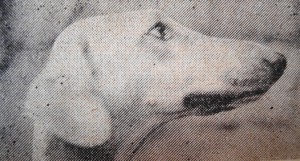
“The story started when Mr. Pečar was an ambassador in Upper Volta and in the Ivory Coast. A government officer gave him a gift, a priceless several centuries old mosaic. A marvellous hound could be seen there. Mr. and Mrs. Pečar explained later: “The beauty of the dog was extraordinary. We fell in love with it at the first sight. We were convinced it was an ancient Roman hound which probably had become extinct long ago.“ However, when they saw “the dog from the mosaic“ in a house of an African chief, this admirable sighthound became the subject of their dreams.
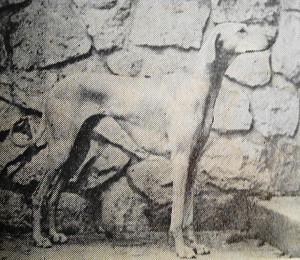
Laca
Friends who the ambassador won in Mali did everything within their power so that upon his return to Yugoslavia, Dr. Pečar could take also two African hounds. Doctor Pečar – while being an ambassador in Mali – had become a reputable and excellent hunter, who gained a name “Big African Hunter“, and in order to acknowledge his hunting achievements, he was given Gao. It was an official gift from the government, and it was really an exceptional dog. Problems arose when doctor Pečar wanted to obtain also a bitch so that he could breed those beautiful dogs. As such dogs can be neither bought nor exported from the country, he turned to the local noblemen, prepared to give or do anything in turn. He was lucky. A tribe of the Touareg that breeds such hounds, agreed to give a bitch to doctor Pečar; however, he, in turn, had to kill and deliver to the tribe an elephant bull – the leader of the herd. Doctor Pečar agreed to fulfil such a difficult task, accomplishing it successfully. He handed over the elephant, the leader of the herd, to the chief of the Touaregs, and in turn, he was given a Sloughi bitch. However, it was a poor little thing, which was supposed to be put down. The Touaregs cull all the bitches from the litter except one, which is kept for breeding. Doctor Pečar had to apply lots of effort and love to keep the poor undernourished little animal alive; in the years to come, this bitch become a dam of several beautiful offspring. At the time when Mr. Pečar was trying to find a Sloughi bitch for himself, he spent some time among the Touaregs and he learnt much about the breeding of these dogs. He told me so before he left to take a new office in Ghana, leaving the care of his dogs in my hands.

Mrs. Vesna Sekalec and her Laca
The Sloughi is bred by the tribe of the Touareg, a Saharan nomad tribe. The Touareg use neither a firearm nor a lance, they even do not use a bow and an arrow for hunting; they do not use but the sighthound and the knife. How do they hunt? During the first year, they feed their young dogs with milk; they never feed the dogs with game meat. Also later, when dogs grow a little, they like drinking milk; besides current food, it is necessary to give them milk till the end of their life. When more than three months old, a puppy is introduced in hunting, starting with hunting of rats and later also rabbits. When the Sloughi is grown up, it is taken for gazelle hunting. The hunter is on the horseback; the hound is sitting before him on the saddle. The man holds reins in one hand, the dog’s collar in the other. When the chase speeds down, the dog jumps off the horse in order to continue the hunt at a wild speed. The chase continues, kilometres being covered; sometimes, it takes five or six hours for the hounds to catch their prey. It is typical for the Sloughi not to kill the game but to bite the tendons of their legs so that the animal would stay alive until the hunter finds it, otherwise meat of dead game would perish in the African sun.
The Touareg travel freely through the African countries, the territories of which extend into the Sahara desert. They appreciate their dogs immensely, as they are their only weapons for hunting, but they also love them very much, considering them family members. Only the best friend may be given a sighthound as a gift. Wealth of the members of the tribe is measured, among other things, by a number of Sloughis which sleep under their roofs.

Laca in the CACIB show in Brno, Czechoslovakia, 1973
Little has been written and little is known about the hounds from Mali. Some consider them the purest breed, because the Touareg who breed them allow their hounds neither to be exported nor crossed. They keep only males from a litter. Females are culled and only those are left which will be kept for breeding. In addition, they select puppies. A Sloughi without white markings is not good; only such dogs are left which have white spots on paws, tail tip and chest. In addition, dogs must have black nails and good pigmentation, and the mandatory five warts on their heads. I was explained this by doctor Pečar once, when I asked about the strange growths on the head of my Laca. He counted five warts and with satisfaction, he told me that Laca was up to the Touareg standard.
So this is the story of how Gao and Lara got to Yugoslavia four years ago, where they have left their offspring. Today, there are 14 Sloughis in our country. Their colour ranges from sand to red, with white markings or without these, with the mandatory black nails and large black eyes with black rims, so that they look like a woman made up for an evening walk.
However, they cannot hunt in my country. In the European hunting terrains, rather reduced as compared to vast African areas, these dogs would not be hunters´ help but they would become independent hunters themselves. However, they may bring beauty and joy to those who will fall in love with them. For a person who does not want to be disturbed in her/his work by frequent exuberant expressions of affection of the dog, the Sloughi will be an ideal companion. Its expression of love is limited just to moments when the dog puts its narrow head on your lap, watching you with its large eyes. Its graceful gazelle movement and gait, different from the gait of the other sighthounds, will take your breath away. Maybe we will see these dogs on racing tracks one day, as the Sloughi is capable of running up to 70 km per hour, and it is easily able to catch a light gazelle.“
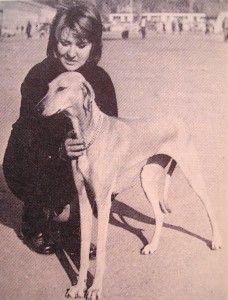
Mrs. Sekalec and Laca
In 1975, the first Azawakhs got to the then Czechoslovakia. These were four dogs from Mrs. Sekalec´s kennel, and she brought them in person to one of the future owners, to Mrs. Jindra Marečková from Počáply by Pardubice. The bitch Assumi Harris Al Sahra (there is a question who was the real sire of Laca´s litter, whether the real Sloughi El Basal Ben Burd von Klein Vossenburg, or Lord Lody, the brother of the dam) was kept by Mrs. Marečková (the Z Počápelské stráně kennel); the bitch Balhara Harris Al Sahra (Toro od Menake x Tibi od Menake, brother x sister cross) was taken by Mrs. Hana Petrusová (the Del Monte kennel); the other two Azawakhs, siblings of the above-mentioned dogs, the male Al Aden and the bitch Baleira, did not stay long with their respective new owners, and finally they were rehomed with Mrs. Petrusová. Dogs from the „A“ Harris al Sahra litter (exported to Czechoslovakia, Poland and Switzerland), and from the „B“ Harris al Sahra litter (exported to Czechoslovakia and the German Federative Republic) became also the breeding foudation for now already legendary kennels in Switzerland (Al Hara´s, the foundation female was Al Hara Harris al Sahra; the first litter was born in 1978) and in the German Federative Republic (Aulad al Sahra, the foundation female was Begum Harris al Sahra, the first “S“ litter was born in 1978), where the first litters, as well as in Czechoslovakia, came from the pure Yugoslavian line.
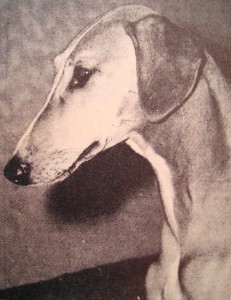
Assumi Harris Al Sahra
Mr. Karel Štěpánský published an article “The Sloughi“ in the Czechoslovak cynological magazine Pes přítel člověka, issue XI/1977. The author also published an extract of a letter written by Mrs. Marečková. Mrs. Marečková´s words are a testimony of the first impressions which this breed, unknown in Europe, made on dog owners who were rather used to cultural breeds and their character:
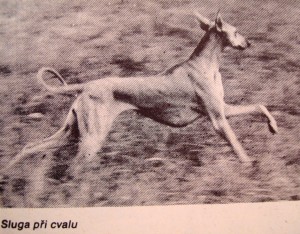
“I met Mrs. Vesna Sekalec from Zagreb,Yugoslavia two years ago in the dog races in Hungary. She admired my Borsoi male Ghazi Arslan z Neuštejna, and she told me about an unknown sighthound similar to the Greyhound, which is, however, faster and which moves like a gazelle. And she showed me her beautiful bitch Lina. I was fascinated by that noble dog, by its elegance and gracefulness of its silhouette. When I learnt that she was a descendant of a dog caught in the wilderness, my wonderment was endless and I could also understand the shyness and sensitivity of the bitch. Since that moment, I had dreamt my dream – to have also a hound like that! Last year, my wish came true - Vesna Sekalec gave me a bitch as a gift. Her name is Assumi Harris al Sahra. She has been living happily in our home together with my Borsois, Collies and Whippets. She playfully wrestles with the Borsois, and many times, she wins her puppy battle. The lively little pup makes me immensely happy; day by day, I follow its development and I record carefully all knowledge, specialities and differences of this breed.
This year, Vesna Sekalec has been invited by the Yugoslavian ambassador in the Republic of Mali to participate in a hunt, during which she plans to select two first-class wild specimens that would become a foundation of a new bloodline in Yugoslavia. She expects that during the hunt, wild dogs will join two already civilised dogs of the ambassador, and if this is the case, it may be possible to catch them.“
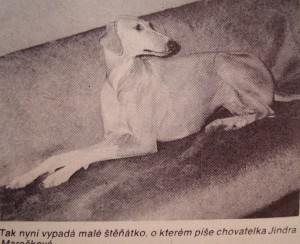
Assumi Harris Al Sahra
In 1977, Mrs. Sekalec visited the then Upper Volta (today’s Burkina Faso) and brought to Mrs. Marečková an adult male Darkoye Sidi in order to enlarge the reduced genepool. Darkoye had a complete four-generation pedigree, however it was completely made up. Such a pedigree, it seems, is not the only inaccuracy in the stud books of those times. The pedigree of the first litter of Mrs. Sekalec,“A“ Harris al Sahra, stated that the sire of the litter was a pure Sloughi, El Basal Ben Burd von Klein Vossenburg. Mrs. Sekalec was trying to find an unrelated male for her Laca, and chose that Sloughi champion. However, from various independent sources and contemporary breeders I have heard a different story, which nowadays can be neither confirmed nor denied (maybe only via genetic testing). The story has it that the Sloughi male did not mate Laca, and Mrs. Sekalec opted for an alternative solution – she paid a visit to Laca´s littermate Lord Lody. Lord Lody is also indicated as sire in the Azawakh pedigree database. That litter was the first one in the Harris al Sahra kennel, but in the pedigree, the originally planned sire was inscribed.
Maybe it is worth clarifying some of the above statements which may sound a bit amusing today, but at the beginning of the seventieth such information was quite exotic. I am referring to information concerning the “five warts“ on the head of the Azawakh, which still may be found in some books on sighthounds, affirming it is true. Such Azawakh “warts“ are, in fact, “tubercles“ from which whiskers grow, two on each cheek, which means four, and the fifth one is located approximately in the centre of the lower jaw. On the long narrow head of the Azawakh grown with extremely short coat, such tubercles are just easier to see as compared to breeds with a longer coat. By no means these are any Azawakh specialty, this is a common feature of the canids in general.
The usage of the word “catching“ may be also misleading when talking about the Azawakh in Africa, as it may be understood as an implication of the fact that the Azawakh lived as a wild non-domesticated animal in the African wilderness, and if a man wished to have one, he had to catch it. This undoubtfully sounds very interesting and it surely added up to the exotic perception of the Azawakh in the past, however, the reality is not that picturesque. It is true that the Azawakh is a less-domesticated breed, however it lives with its owners and it takes part in their every-day life.
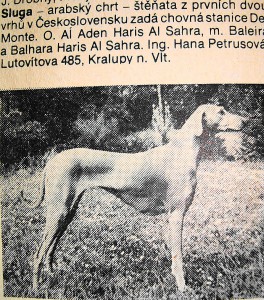
The advertisement of the first two litters of the Azawakh in the Del Monte kennel, November 1977
Already in 1977, three litters were registered in the then Czechoslovakia. The first two ones were born in the Del Monte kennel (19th September 1977 A – del Monte, 3 males, 2 females, parents Al Aden Harris al Sahra x Balhara Harris al Sahra; 25th September 1977 B-del Monte, 2 females, parents Al Aden Harris al Sahra x Baleira Harris al Sahra). At the end of the same year, the “A“ litter was born in the z Počápelské stráně kennel (5 males, 2 females, parents Darkoye Sidi x Assumi Harris al Sahra). The Czech Republic therefore belongs among the countries with the longest tradition of the breeding of the Azawakh outside Africa.

Young dogs from the first Czech litters in their first racing training, November 1978
The Azawakh breeding had a good start in Czechoslovakia, but it almost ended at the same time. It was clearly understood that the dogs of the Yugoslavian line were not Sloughis and that they belonged to an independent breed, but officially, there was only one standard for both breeds. Contrary to clubs in Germany, Switzerland and France, where breeders did not have to overcome such obstacles, the then Czechoslovak Sighthound Club decided to proceed in a very strict manner, forbidding to breed forward from the dogs of the del Monte and z Počápelské stráně kennels. Such dogs really were not up to the FCI standard, their morphology was different and they had white markings, which are considered an excluding fault in the Sloughi. Azawakh fanciers had to face difficult times full of uncertainties, and some of the new Azawakh owners and admirers succumbed to the pressure and bullying by the Club, losing their interest in the breed.
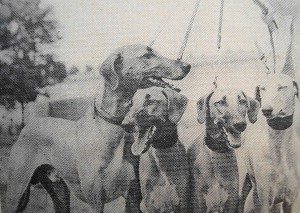
Darkoye Sidi (left) with his offspring and Assumi Harris Al Sahra (right), the Z počapelské stráně kennel, 1978
Already in 1978, Mrs. A. Stuchlá published an article The Azawakh Sighthound in the cynological magazine Pes přítel člověka. That was probably for the first time when somebody expressed an opinion that the current situation was damaging the breeding of a new breed in Czechoslovakia. The article was published one year after the birth of the first litters, and one year after the publishing of the article of Mr. Štěpánský, who presented the Azawakh as Sloughi then. Mrs. Stuchlá mentioned the fact that the first discussions on similarities and differences between the Sloughi and the Azawakh had started already in 1972. Her article, among others, states the following:
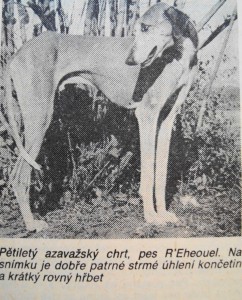
R´Eheouel, a five-year old male; picture shows open angulation and short straight back, A. Stuchlá, 1978
“The issue of differences between the Azawakh and the Sloughi has been addressed also by the UICL (the international organisation of sighthound breeders) and by the Commission for Sighthounds of the FCI since 1972. Such organisations have come to a conclusion that the crossing of these two breeds is undesirable, and they recommended a standard of the Azawakh be created soon. In 1973, the standard for the Sloughi was approved under the number 188c, and at present, the FCI Standard Commission has been already submitted the Azawakh standard for approval.
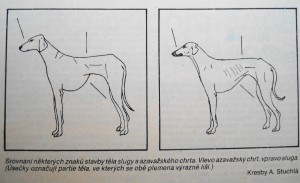
Comparison of diferences between the Azawakh (left) and the Sloughi, A. Stuchlá, 1978
However, both breeds are judged together in the majority of shows, which, of course, has a negative impact on the Azawakh. Only in France both breeds are judged separately. Also in the German Federative Republic, dogs imported from France and denominated as Azawakh in their pedigrees are judged separately. In the majority of the cases, the specimens of this breed are denominated incorrectly as Sloughis in their pedigrees, which is a common situation in whole Europe. In order to be able to keep the Azawakh alive as a breed, it is paramount to judge these two breeds separately in shows, as judging according to the Sloughi standard endangers the very existence of the Azawakh (almost all the specimen are rejected as non-typical when judged according to the Sloughi standard). Such a problem affects deeply also the breeding in Czechoslovakia.
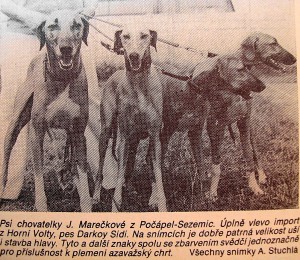
"Dogs of Mrs. Marečková, the Z Počapelské stráně kennel; Daroye Sidi on the left - the picture shows the size of the ears and shape of the head. Such features, together with the colour, are a perfect evidence of the fact that the dogs belong to the Azawakh breed." Author: A. Stuchlá, 1978
Darkoye Sidi, a male imported by professor Sekalec from Upper Volta, has not been given the breeding permission. The male has been living with the breeder J. Marečková from Počáply-Sezemice. He is a typical representative of the breed to which he belongs – the Azawakh Sighthound. The breeding permission was not granted to this male due to white markings on his legs and due to some morphological characteristics which are not in compliance with the Sloughi standard according to which this male was evaluated. This dog naturally cannot conform to the Sloughi standard, because he is not a Sloughi, not even from the point of view of the place of its origin (Upper Volta is located south of the Sahara desert) and morphology; this male is a typical Azawakh, as well as the other specimens of the breed in Czechoslovakia, considered Sloughis until now. The fact that the FCI still has not issued the Azawakh standard makes the situation even worse. Only France has issued a standard for this breed so far.“
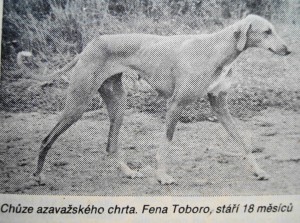
Movement of the Azawakh. Toboro, female, 18 months old

The Azawakh trotting. Ouahed, male, 10 months (Aikar x Toboro)
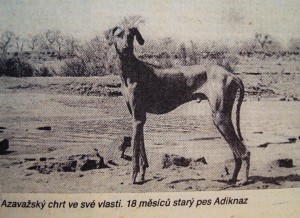
An Azawakh in its homeland. Adiknaz, an 18-month old male.
The uncertain situation surrounding the Azawakh prolonged until 1981, when the FCI finally recognised the Azawakh and a standard for the breed was issued. The standard had been officially recognised from 3rd July 1980 and it entered in force on 1st January 1981. In the first standard, the breed was denominated “Sloughi Azawakh“; however, such a name was changed shortly after that. North Africa was given as the place of the origin of the breed without any detailed specification of any country or region, and France became the patronage country. So finally, as of 1st January 1981, the existence of this ancient, centuries old breed was officially recognised by the FCI, and the standard entered into force.
Even before the standard became officially valid, when it was already known that the breed would be recognised, judging of breeding stock was organised on 1st November 1980 in the city of Kolín, Czechoslovakia. All the Azawakhs, even those that had been registered as breeding stock as Sloughis, had to attend. No new pedigrees were issued for such dogs; in their pedigrees, a simple correction was made – the word “Sloughi“ was crossed out and replaced with the word “Azawakh“. Dogs also did not lose their show titles awarded to them when they were judged as Sloughis, obtaining therefore national or international championships on the basis of titles awarded in fact to two different breeds according to two different standards.
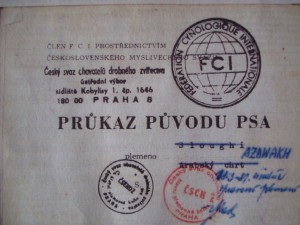
The pedigree of the male Amon z Počapelské stráně, the Azawakh magazine, 4/2005, author of the original picture O. Kupka
Since the beginning of the eighties it seemed that nothing would impede the breeding of the Azawakh and that a bright future awaited the breed. However, both historical and contemporary events are an evidence of the fact that nothing is as easy as it may seem.
The very first standard, in terms of the definition of the permitted colours, mentioned also the brindle colour, which, however, was forbidden after a short time, and it was permitted again as late as in 1994. The standard has been amended several times in the course of the years, but unfortunately not in such a range so as to reflect the African reality of the breed in general. Just in the last approximately twelve years, there have been four recommendations issued by SLAG, the French patronage club, concerning the breeding and judging of the Azawakh. Such recommendations, unfortunately, have been far from being beneficial for the breed, but they have also been in absolute contradiction one with another or in contradiction with the general laws of genetics and genetics of small populations.

Approximately at the end of the nineties, it was required by the show judges that the Azawakh had rather large symmetric white markings, reaching up to the half of the front legs or higher. After that, there was a concern about the genetic variability of the breed – fully justified – based on the fact that the genepool of the Azawakh in Europe was so small that it would endanger a healthy development of the breed. For such a reason, a recommendation was issued that the genepool should be enlarged, and in order to achieve that, the Sloughi should be bred to the Azawakh. In response, a strong protest movement arose of fanciers and breeders of both breeds and clubs from all parts of the world signed petitions against such a recommendation, argumenting that in Africa, there was still a rather rich quality genepool of the breed which could be used to extend the reduced European one. However, such arguments were not even considered by the SLAG representatives, and until now, nobody has officially cancelled such a recommendation. Finally, common sense won over the establishment and the breeders were wise enough not to abide by such a decision. However, some years after that, another recommendation was issued to penalise Azawakhs with large white markings in shows, and ideal markings became suddenly only traits of white on fingers and a little white spot on the chest. A protest movement arose again, and Azawakh fanciers and breeders organised a signature campaign against such a requirement. Their arguments that such an approach would reduce the small genepool even more, were not considered sufficiently important by the same cynological representatives who, several years before, had suggested to cross Sloughis to Azawakhs in order to protect the breed from extinction. Some time passed and it was recommended, more or less silently, that dogs with white markings should not be necessarily punished to such an extreme. Breeding of not just a rare, but any breed in general, under such conditions is a rather difficult task indeed.
So we, lovers and admirers of the Azawakh, hope a day will come when personal ambitions and interests and quest for show fame will be overcome by a real love for dogs, common sense, scientific approach and genetics. Let’s hope that the graceful hound from the ancient mosaic will stay with us, a precious jewel shining from far-away times and culture, adorning our lives with the beauty of its body and soul.

Sources:
Dana Kupková; Oldřich Kupka, The 30th Anniversary of Azawakh Breeding in the Czech Republic, The Azawakh magazine, 4/2005
The Pes přítel člověka magazine, issues 1977, 1978
The Stud Book of the Czech Republic
The Azawakh Pedigree Database




